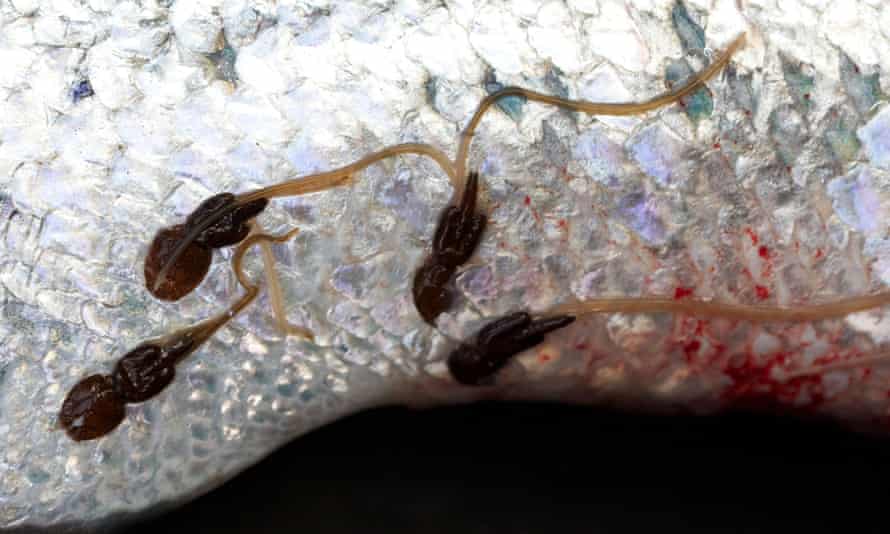The Scottish government appears ready to approve a banned insecticide blamed for destroying bee populations for use in Scottish salmon farms, according to internal documents seen by the Guardian, as MEPs warn of its potentially “devastating” impact on aquatic life.
The insecticide is one of three nicotine-based, or neonicotinoid, chemicals banned by the European Union in 2018 for agricultural use on crops, a decision upheld this month by the EU’s top court, the European court of justice, which rejected an appeal by the Bayer chemical multinational. The ban does not apply to rivers or the sea.
US government scientists have described the insecticide imidacloprid as an “environmental hazard” that can be “very toxic to aquatic life with long-lasting effects”.
An investigative news site, The Ferret, first revealed in March 2020 that the Scottish fish farming industry was planning to use imidacloprid to kill the sea lice that can infest caged salmon.
A series of emails, released under the Freedom of Information Act, reveal the Scottish government appears to be smoothing the path for CleanTreat – a system that uses the insecticide to rid farmed salmon of sea lice, to be accepted for regulatory approval in Scottish fish farms.
Annabel Turpie, director of Marine Scotland, the agency of the Scottish government that manages fisheries, has said she would help with the environmental regulators on the new system, which uses imidacloprid. In correspondence with officials on 1 March 2021, Turpie wrote: “I’ve said we’ll help with engagement with Sepa [Scottish Environment Protection Agency] and MSS [Marine Scotland Science] on the CleanTreat technology.”
On 10 March she referred to actions of the Scottish government’s Sustainable Aquaculture Innovation Centre (SAIC) “around support to navigate CleanTreat through the system“. She was “aware the intention is for CleanTreat to come forward the second half of the year, assuming regulatory approval”, she said, but that an application had not yet been submitted. There was an “expectation” that Benchmark, the fish farm biotechnology company that makes CleanTreat, would “bring it onto an existing site for approval”, she said.
Later in March, Turpie was briefed by officials ahead of a meeting with a fish farming company, suggesting lines she could take, including that the CleanTreat technology would be given “welcomed consideration”.
“We can’t circumnavigate Sepa’s consideration as they have to follow legal process,” the briefing said. “But there is a newly invigorated dedication within SG [Scottish government] and across regulators to support innovation in the aquaculture sector – am confident this will be given welcomed consideration when an application is received.”

This week, the European Commission were urged to withdraw a draft regulation authorising safe limits of imidacloprid for farmed fish, amid warnings of its “toxic” impact in rivers and waterways. A resolution by a Green MEP, to be put before the commission’s environment committee for a vote on Thursday, calls for imidacloprid to be instead listed as an emerging environmental contaminant for which no maximum levels can be set for aquatic use.
Grace O’ Sullivan, Green MEP for Ireland South, who tabled the resolution, said she was “very concerned” about the potential use of the insecticide in salmon farming as a treatment against the sea louse, a small crustacean that feeds on the mucus, epidermal tissue, and blood of host marine fish.
“This is particularly worrying in Scotland, which has a large salmon aquaculture industry and tradition, but also for the EU, where the commission is proposing to establish a maximum residue level (MRL) for imidacloprid.”
“This MRL will allow companies to apply for marketing authorisation for the product, and apply it in the salmon farming industry in particular, where it will in all likelihood spill into the marine environment to the detriment of ocean health and biodiversity.”
O’Sullivan, a member of the European parliament’s environment committee, said her objection called on the commission to withdraw its draft implementing legislation and include imidacloprid in a list of “pharmacologically active” substances, for which no maximum levels can be fixed for the aquatic environment.
“There is increasing evidence that the use of imidacloprid has a devastating impact on rivers and waterways, not only affecting crustaceans and insect species but also soil organisms and bird populations,” she said. “Its use in Japan has already led to a dramatic collapse of fish stocks that have not recovered.”
Concern is growing over the potential impact on aquatic life of non-agricultural use of the pesticide, including as a flea treatment in pets, after a study last year found imidacloprid in two-thirds of English rivers.
Benchmark described CleanTreat as a “breakthrough” development for the salmon farming industry. It is a filtration system that would remove chemicals from fish farm treatment water in a “closed contained system” on ships before purified water is returned to the sea.

Dave Goulson, a biology professor at Sussex University, and part of the team that identified the neonicotinoid in 66% of 20 English rivers analysed by the Environment Agency in 2016-18, said: “Most members of the public think they have been banned and the problem has been solved. But with its use on dogs [as a pet flea treatment] and now in fish farms, it’s like the wild west.
“These chemicals are incredibly poisonous – the novichok for insects,” he said. “It takes a billionth of a gram to harm aquatic life, so even tiny traces would have major impacts on marine life.”
The CleanTreat system, which claims to remove imidacloprid from water “clearly needs to be tested by an independent laboratory”, the professor said.
Don Staniford, the campaigner behind Scottish Salmon Watch, which obtained the emails under freedom of information legislation, said: “The Scottish government are paving the way for this toxic chemical to be used even before the environmental risk assessments are published. They should be on the side of science and the environment, not on the side of a Norwegian-owned company peddling a banned neonicotinoid.”
A spokesperson for the Scottish government said it routinely promoted innovation across the economy, including in fish farming. This included providing “procedural and technical” guidance to private-sector organisations in industry.
All aquaculture farms are regulated and must meet “strict guidelines to ensure the environmental effects are assessed and managed safely”, the spokesperson said.
Any new product must undergo “rigorous testing before any approval is granted”, including by Sepa, they added.
“Any use of the new medicine imidacloprid would require authorisation from Sepa, which has received no application to use imidacloprid, nor has it had any pre-application discussions about this.”
A spokesperson for Sepa confirmed it had had “no pre-application discussions, nor received an application to discharge imidacloprid” as a trial or otherwise from Benchmark or any other companies.
The spokesperson said: “Trials of any new medicine that would involve a discharge of residues into the environment would require authorisation, and discharges into the sea from land, fish pens or well-boats require a permit from Sepa.”
A spokesperson for Benchmark said: “CleanTreat is an award-winning and validated water-purification system, which safely removes sea-lice medicine from treatment water in a closed contained unit before returning purified water back into the sea.
“We are currently focused on launching our new sea-lice solution, BMK08, which is used together with CleanTreat, in Norway. At this time we do not have any scheduled trials for BMK08 in Scotland.”
BMKO8 medicine uses imidacloprid, according to Benchmark.